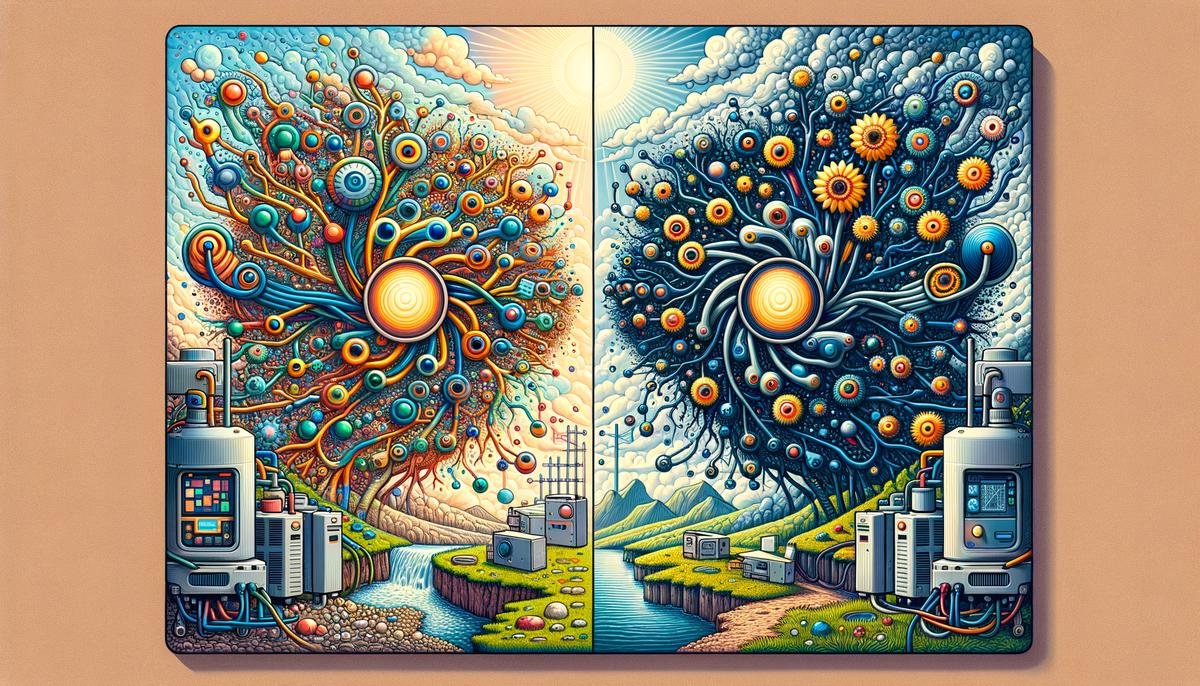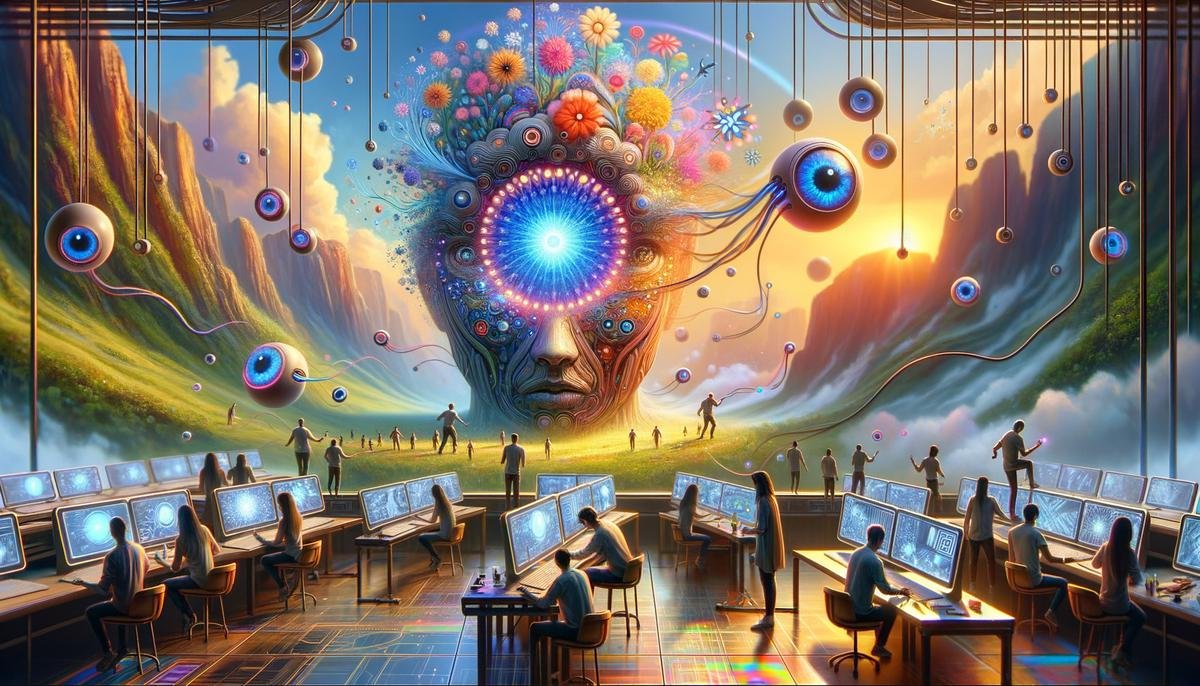Understanding Artbreeder's Generative AI Algorithms
Artbreeder uses Generative Adversarial Networks (GANs), which consist of a generator and a discriminator neural network. The generator creates images, starting with random noise, while the discriminator evaluates the output to distinguish it from real images. Over time, the generator improves, creating increasingly realistic images.
Artbreeder's machine learning process involves training the model on a large dataset of images. The generator learns to capture patterns and features, while the discriminator improves at identifying realistic elements. This ongoing learning allows Artbreeder to continuously refine its output.
Users can manipulate images by editing genes, which refer to attributes like lighting, color, and facial features. The AI generates variations in real-time based on these changes. Artbreeder also enables complex transformations, such as changing facial expressions, combining stylistic elements, and producing animated versions.
The algorithms enhance image quality by filling in details and improving clarity, even for low-quality uploads. Users can also blend multiple images to create hybrids, mixing traits from each. The generator synthesizes the features of input images into a cohesive output.
Artbreeder's technology leverages advanced GANs and machine learning to offer a robust platform for producing and enhancing digital art.1 The combination of cutting-edge algorithms and user-friendly tools makes it a powerful resource for digital artists.

Applications of Artbreeder in Digital Art Creation
Artbreeder's tools are applicable to various forms of digital art creation:
- Portraits: Artists can adjust facial attributes, lighting, and skin tones to create personalized images.
- Landscapes: Artists can blend different scenes to generate realistic or fantastical environments, manipulating elements like time of day and weather conditions.
- Abstract art: Artbreeder's ability to merge visual elements allows for the exploration of new artistic styles and surreal compositions.
- Typography and graphic design: Designers can create unique textural backgrounds and integrate stylized visuals into their projects, such as book covers or digital ads.
- Animation: Artbreeder helps generate characters and backgrounds for storyboards and concept art.
- Education: It serves as a teaching tool to demonstrate how artistic elements can be combined to create new forms.
Whether enhancing portraits, crafting landscapes, generating abstract art, or aiding in graphic design and animation, Artbreeder empowers artists to explore new creative horizons and produce visually stunning artwork.2

User Experience and Interface of Artbreeder
Artbreeder's platform offers an intuitive experience for both beginners and advanced users. The interface is clean and well-organized, with a straightforward dashboard highlighting the main tools and features. Essential functions are easily accessible, and the primary workspace is uncluttered, featuring sliders and dropdowns for adjusting image attributes.
For beginners, Artbreeder provides an accessible entry point into AI-generated art. Users can explore pre-existing images and apply simple edits, gradually learning advanced features. Immediate results help build confidence and encourage experimentation. Advanced users appreciate the depth and versatility of the platform, with sophisticated options for combining and morphing images, adjusting hundreds of genes, and enhancing image quality.
Artbreeder's Explore and Community sections enrich the user experience by providing a gallery of user-submitted creations for inspiration and understanding the platform's potential. Users can browse artworks, discover trends, and build upon others' work with proper attribution, fostering a collaborative environment.
The platform's interactive tools include:
- Drag-and-drop functionality for blending images
- Real-time sliders for adjusting attributes
- Instant downloading of work
- Image Upscaler and Enhancement tools to improve image resolution and detail with minimal effort
Artbreeder's thoughtfully crafted interface caters to a wide range of users, offering an intuitive layout, robust features, and a strong community aspect, making it a powerful tool and welcoming space for artistic experimentation and growth.
Ethical and Legal Considerations in AI-Generated Art
AI-generated art platforms like Artbreeder present ethical and legal considerations for creators. Authorship becomes ambiguous when an artwork is generated using AI, raising questions about who the true 'artist' is. Artbreeder addresses this by allowing users to claim creative ownership, emphasizing the user's input and choices in the final output.
Copyright is another significant concern, as traditional laws protect works created by human authors. The legal landscape regarding AI-generated works varies, and users should be aware of these differences when commercializing their creations.
Bias in AI algorithms is a multifaceted issue, as training datasets may contain inherent biases reflecting real-world prejudices and inequalities. Artbreeder and other platforms work to improve their datasets and algorithms to minimize bias, but users should critically assess the inclusivity and diversity of their AI-generated results.3
When sharing AI-generated art, users must be conscious of potential implications, ensuring proper attribution and respecting fellow creators' rights. Artbreeder promotes a culture of collaboration and sharing, where adaptations are built upon mutual respect and consent.
The potential misuse of AI-generated art, such as deepfakes and manipulative media, poses ethical complexities. While Artbreeder's primary purpose is to enhance creativity and artistic expression, users must be mindful of ethical boundaries and ensure their creations do not harm, deceive, or infringe upon others' rights.
As AI-generated art evolves, addressing ethical and legal ramifications thoughtfully is crucial. Artbreeder's transparent practices and community-driven approach aim to navigate these challenges, but users also have a responsibility to remain informed and conscientious in their creative endeavors. By recognizing the intricacies of authorship, copyright, bias, and ethical use, artists can responsibly harness AI's power to push digital art boundaries while upholding integrity and respect within the artistic community.
Future Trends in AI-Generated Art with Artbreeder
Looking ahead, advancements in AI technology will likely expand the capabilities of Artbreeder's platform. One key area of growth is the enhancement of realism and detail in generated images. With improvements in neural networks and data processing, Artbreeder could incorporate more sophisticated algorithms that produce highly realistic art, blurring the lines between AI-generated images and traditional photography. This would open up new possibilities for artists, photographers, and graphic designers who seek to achieve a high level of precision and realism in their work.
Another promising trend is the increased personalization of AI-generated art. As Artbreeder continues to refine its machine learning models, the platform could introduce more nuanced customization features, allowing artists to define specific parameters and obtain results that closely align with their artistic vision. Users could input their artistic style, preferred color palettes, and thematic preferences, and Artbreeder could generate art that matches their unique aesthetic.
Interactivity is also set to become a significant focus for future AI art platforms. Artbreeder could move toward more dynamic and interactive creation experiences, where users can engage with their art in real time. Integrating VR (Virtual Reality) and AR (Augmented Reality) technologies could provide artists with immersive environments to create and manipulate their digital masterpieces. Such integrations would allow artists to interact with their art in three-dimensional spaces, leading to more engaging creative processes.
Artbreeder might also evolve to offer even more collaborative features. By fostering community-driven projects and real-time collaboration tools, the platform can enhance the collective creative experience. Artists from around the globe could come together to co-create pieces, share techniques, and inspire each other in new ways. This level of collaboration could give rise to a global community of digital artists, united by their use of advanced AI tools.
AI's role in art education could also be amplified in the coming years. Artbreeder has the potential to serve as an educational resource, offering tutorials and guided projects that teach users about different artistic techniques and styles. By partnering with educational institutions and art programs, Artbreeder could become an integral part of the curriculum, equipping the next generation of artists with the skills and tools to thrive in the digital age.
As ethical and legal frameworks around AI-generated art continue to develop, Artbreeder could take proactive steps to ensure its platform adheres to these emerging standards. This might include implementing mechanisms for tracking and verifying authorship, ensuring proper attribution, and protecting intellectual property rights. By prioritizing transparency and ethical considerations, Artbreeder can build trust and integrity within the digital art community.
To meet the evolving needs of digital artists, Artbreeder may also explore new business models and monetization strategies. Offering subscription tiers with premium features, access to exclusive content, and advanced tools could cater to both casual users and professional artists. Such models would enable Artbreeder to sustain growth while continuing to innovate and provide value to its user base.

Artbreeder's innovative use of AI and machine learning is reshaping digital art creation, providing artists with powerful tools to expand their creative horizons. As the platform continues to evolve, it promises to remain a significant asset for artists seeking to push the boundaries of their craft. With the potential for enhanced realism, personalization, interactivity, collaboration, and educational resources, Artbreeder is poised to play a crucial role in shaping the future of digital art.1


